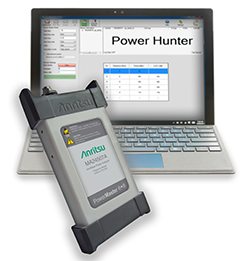Anritsu launched a smartphone-sized, USB-powered millimeter wave power analyzer for radio frequency power within the range from 9 kilohertz to 70 gigahertz. The company said the new Power Master MA24507A is the world’s first frequency selectable radio frequency power analyzer and can be used for testing

802.11ad and E-band products as well as wireless HD signals. The device is a bit larger than a smartphone, at 6 inches by 3 inches by 1 inch and a weight less than 15 ounces. Anritsu said this makes it small and light enough to be placed directly at the signal source, either with an extension pole to measure small cell signals from the ground or “including on-wafer measurements.”. Attenuation becomes a more significant problem at mm wave frequencies, the company noted, so the ability to place a power analyzer close to the signal source enables more accurate measurements. Anritsu added that the instrument can also make measurements as low as -90 decibel-milliwatts at 70 GHz.
Other test companies, such as Signal Hound, have been offering small, light, USB-powered instruments for some time. Signal Hound, which focuses on spectrum analyzers, has even seen its equipment mounted on drones for antenna characterization.
Anritsu added that no reference calibration is needed for its new power analyzer and that it is capable of frequency-selective power measurements in order to differentiate between intended and unintended signals.
In other test news this week:
– The spectrum analyzer market is expected to grow to around $1.75 billion in value by 2022, according to a new report from Markets and Markets. The spectrum analyzer market was valued at around $999.2 million in 2015, the firm said, and it expects the market to grow at a compound annual growth rate of 8.48% over the next seven years. In particular, the market for spectrum analyzers at frequencies greater than 18 GHz is forecast to grow at the fastest rate due to demand in the telecom and defense markets.
– Wi-Fi Alliance delivered the final version of its LTE-U/Wi-Fi coexistence test plan this week. Read the full story here.
– Keysight Technologies expanded its support for small cell testing with its Propsim F32 channel emulator to include more performance testing of devices and network equipment that rely on small cells and carrier aggregation of LTE at 5 GHz using License-Assisted Access. Users can now assess “all existing, as well as planned, LTE-LAA carrier aggregation and Wi-Fi offloading field deployment scenarios,” according to Keysight. The company added that it has developed specific tests for LTE-Hi small cell infrastructure deployments in China.
– iBwave has joined Cisco’s partner program as a solution partner to serve mutual customers with Wi-Fi and cellular network planning tools. This opens up a new sales channel for iBwave in the enterprise space. Claude Echahamian, CEO of iBwave, said in a statement on the partnership that “demand for more integrated heterogeneous networks is on the rise” due to technology convergence and the rise of the “internet of things.”
– EXFO launched a number of solutions for testing in a network equipment manufacturing environment, all of which can be remotely managed through the company’s Multilink systems. The optical switches, power meter and variable attenuator for bit-error rate testing are all compatible with EXFO’s LTB-8 rackmount platform.
– GL Communications added new features, including automatic handling of Signalling Connection Control Part parameters and low balance call flow scenarios to its Maps Intelligent Network Application Part and Customized Applications for Mobile Networks Enhanced Logic Application Part protocol emulators.
– Teledyne LeCroy launched two new optical testing products, an optical-to-electrical converter and a coherent optical receiver, for data center, metro and long-haul use cases.
– Intertek has been stepping up its focus on lithium-ion battery testing in its network of labs. The company, which offers battery certification, performance verification and failure analysis, has been hosting webinars and offering white papers and technical seminars on lithium-ion battery quality and safety issues.
– Tektronix plans to have new features available for its optical modulation analyzer software that will support testing of multichannel modulation schemes with a single measurement system, so that engineers can calibrate and control multiple OMAs to collect data from multiple channels. The new release will be available for download by the end of this year, the company said.
– SAP this week hosted the second working meeting of the Industrial Internet Consortium and Plattform Industrie 4.0, which are collaborating to ensure compatibility between reference architecture models for the IoT as well as and making it easier for companies to access test environments for IoT. More than 300 people attended the meeting, the IIC reported.

